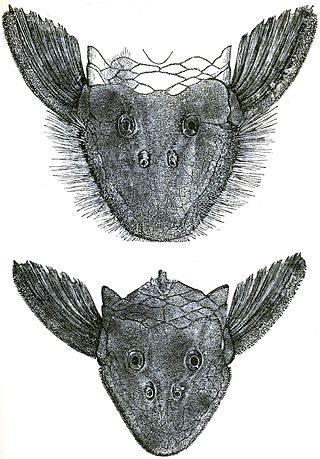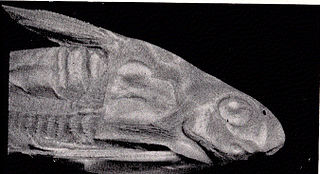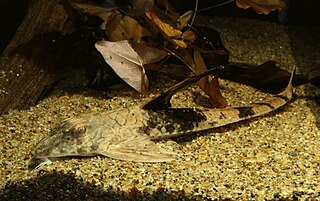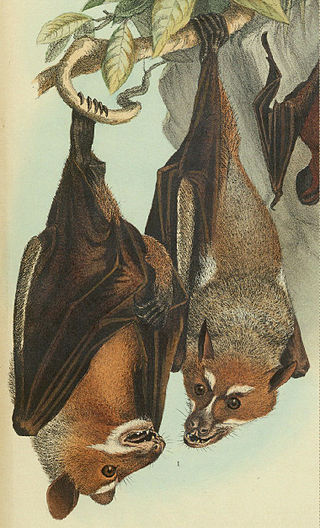
Ancistrus is a genus of nocturnal freshwater fish in the family Loricariidae of order Siluriformes, native to freshwater habitats in South America and Panama. Fish of this genus are common in the aquarium trade where they are known as bushynose or bristlenose catfish. In the aquarium hobby they are often referred to as bushynose or bristlenose plecos instead, but this may lead to confusion as "pleco" usually is used for Hypostomus plecostomus and its allies and is often used as a catchall term for any loricariids remotely resembling that species.
The Dreissenidae are a family of small freshwater mussels, aquatic bivalve molluscs. They attach themselves to stones or to any other hard surface using a byssus. The shells of these bivalves are shaped somewhat like those of true mussels, and they also attach themselves to a hard substrate using a byssus; however, this group is not at all closely related to true mussels, being more closely related to the venus clams (Veneridae).

Baryancistrus is a genus of freshwater Loricariid catfish. They inhabit flowing sections of rivers, especially clearwater, in the basins of the Amazon and Orinoco in Brazil and Venezuela. The largest species reach up to 34 cm (13 in) in total length.

Pseudancistrus is a genus of suckermouth armored catfishes native to South America.

Hemiancistrus is a genus of suckermouth armored catfishes. These species are native to South America. The taxonomy of this genus is complex and unclear, and major work has to be done. Many of these fish are popular aquarium fish.

Corymbophanes is a genus of armored catfish native to South America where they are only known from Guyana. Corymbophanes was originally placed in its own tribe Corymbophanini, but the first comprehensive molecular phylogenetic analysis of the subfamily Hypostominae found Corymbophanes to be nested within the tribe Ancistrini.

Platydoras is a small genus of thorny catfishes native to freshwater habitats in subtropical and tropical South America.

Doras is a genus of thorny catfishes native to tropical South America.

Trachydoras is a genus of fish in the family Doradidae native to South America.

Leptodoras is a genus of thorny catfishes native to South America.
Rhynchodoras is a small genus of thorny catfishes native to South America. Rhynchodoras is closely related to Rhinodoras and Orinocodoras.
Hassar is a genus of thorny catfishes native to South America.

Loricaria is a genus of armored catfish native to South America.
Pseudobagarius is a genus of catfishes of the family Akysidae.

The Wallace's or Sulawesi stripe-faced fruit bat is a species of megabat in the family Pteropodidae. It is endemic to Sulawesi and the nearby Togian Islands of Indonesia. Cave paintings resembling these bats have been found in Australia, where bats of this kind are not otherwise known.
Xyliphius is a genus of banjo catfishes from South America.
Rhinodoras gallagheri is a species of thorny catfish known from Apure River, Capanaparo River, and Arauca River, all left bank tributaries of the middle Orinoco, in the llanos regions of Apure and Barinas States of Venezuela. It is also known from the Aguas de Limon River in the Arauca Department of Colombia. This species grows to a length of 14.95 centimetres (5.89 in) SL.

Apteronotus is a genus of weakly electric knifefish in the family Apteronotidae, distinguished by the presence of a tiny tail fin. This genus is restricted to tropical and subtropical South America and Panama where found in a wide range of freshwater habitats. They feed on small animals.
Ossancora is a genus of thorny catfish native to tropical South America.
Baraguatherium is an extinct genus of ground sloths of the family Mylodontidae that lived during the Early Miocene of what is now Venezuela. It dates to the Early Miocene, around 20.44 to 15.97 million years ago and represents the oldest representative of its family in the northern part of South America to date. The structure of the teeth suggests that the genus represents a rather basal form within the Mylodontidae. Unlike other mylodonts, which tended to prefer open grasslands, Baraguatherium lived in a riverine, coastal tropical rainforest.











